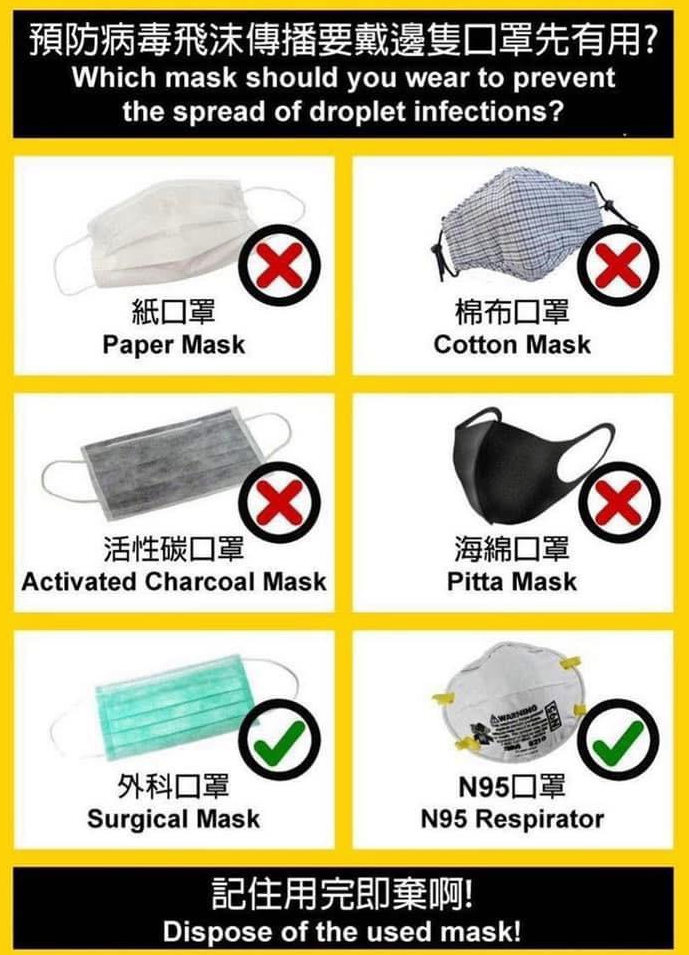Ahh, the Great Mask Debate. How very 2020. The N45s don’t stop exhalation spreading the virus, the surgical ones are ineffective quickly out, the fabric ones create as many problems as they resolve. This is not logical and yet every time I see another human I put one on to make them feel more comfortable.
Before you read this, please take our POLL.
So, let’s look at mask science: Yesterday’s Scientific Dogma is Today’s Discarded Fable.
Surgical masks
Also called a medical mask, a surgical mask is a loose-fitting disposable mask that protects the wearer’s nose and mouth from contact with droplets, splashes and sprays that may contain germs. A surgical mask also filters out large particles in the air. Surgical masks may protect others by reducing exposure to the saliva and respiratory secretions of the mask wearer.
Surgical Mask were designed and approved for STERILE environments. The amount of particles and contaminants in the outside and indoor environments where people are CLOGGING these masks very, VERY quickly. The moisture from your breath combined with the clogged mask will render it “useless” IF you come in contact with Covid and your mask traps it, YOU become a walking virus dispenser. Everytime you put your mask on you are breathing the germs from EVERYWHERE you went. They should be changed or thrown out every “20-30 minutes in a non sterile environment.”
At this time, the U.S. Food and Drug Administration has not approved any type of surgical mask specifically for protection against the coronavirus, but these masks may provide some protection when N95 masks are not available. It should be replaced when damp or soiled and applied and removed after sanitizing hands.
N95 masks
Actually a type of respirator, an N95 mask offers more protection than a surgical mask does because it can filter out both large and small particles when the wearer inhales. With this type of mask, unfiltered air is released when the wearer exhales.
The N45 mask stops 95 percent of small particulates entering into the mask, but vents the exhale for little to no reduction of particulates going out, meaning lots of protection to you but little to no protection to others. If you want to protect both others and yourself, the best method I know of is to wear the N95 and then put a surgical mask over that, so face —> N95 —> surgical mask. You also need to change the surgical mask because they are rated for a sterile environment, so no one can be really sure how they hold up outside where they pick up everything. I’ve read from anywhere to 30 minutes to an hour. (Nicholas Watts)
Like surgical masks, N95 masks are intended to be disposable. However, researchers are testing ways to disinfect N95 masks so they can be reused.
Some N95 masks, and even some cloth masks, have one-way valves that make them easier to breathe through. But because the valve releases unfiltered air when the wearer breathes out, this type of mask doesn’t prevent the wearer from spreading the virus. For this reason, some places have banned them.
Cloth masks
Cloth masks are easy to find and can be homemade, washed and reused.
- Washability of the mask is important. Remember, to sterilize, you need to use the hot water cycle in the washer, and heat dry. For this reason, synthetic fabrics may not be good.
- Make sure you don’t touch the mask (or any of these masks) when you wear it. It may have contaminants on the surface. Leave it on until you get home and wash your hands after you do take it off.
- Take off your mask when you get home. Place it in a plastic bag until you’re ready to do laundry. Masks should be treated as dirty and contaminated after each use.
Cloth masks are cheap and simple to make. Instructions are easy to find online. Masks can be made from common materials, such as sheets made of tightly woven cotton. The CDC website even includes directions for no-sew masks made from bandannas and T-shirts. Cloth masks should include multiple layers of fabric. The best will be made from anti-microbial fabric. Some patterns suggest inserting a disposable surgical mask. This is not based on science but street commonsense. If you reuse these surgical masks and have the virus – you’ll just be passing it on.
Remember there is limited filtering. As you exhale, you are ridding your lungs of contaminants and carbon dioxide. Cloth masks trap this carbon dioxide the best. The moisture caught in these masks can become mildew ridden over night. Dry coughing, enhanced allergies, sore throat are all symptoms of a micro-mold in your mask. Hygiene is crucial.
How to wear a cloth face mask
Cloth face masks should be worn in public settings where social distancing measures are difficult to maintain, such as in grocery stores, especially in areas of significant community-based transmission.
Here are a few pointers for putting on and taking off a cloth mask:
- Place your mask over your mouth and nose.
- Tie it behind your head or use ear loops and make sure it’s snug.
- Don’t touch your mask while wearing it.
- If you accidentally touch your mask, wash or sanitize your hands.
- Remove the mask by untying it or lifting off the ear loops without touching the front of the mask or your face.
- Wash your hands immediately after removing your mask.
- Regularly wash your mask with soap and water in the washing machine. It’s fine to launder it with other clothes.
